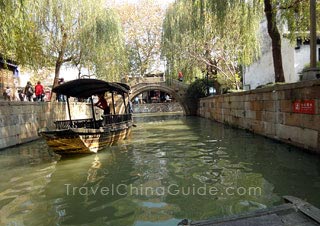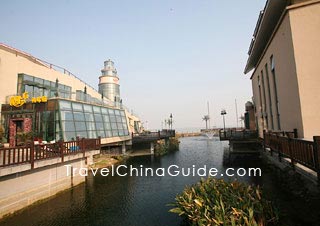Huzhou Travel Guide
Huzhou Facts
Chinese Name: 湖州 (hú zhōu)
Population: 2,980,000
Area: 5,820 square kilometers (2,247 square miles)
Location: in the north of Zhejiang, east China
Administrative Division: 2 districts (Wuxing, Nanxun); 3 counties (Changxing, Deqing, Anji)
Area Code: 0572
Zip Code: 313000
GDP (2019): CNY 312.24 billion (USD 45.26 billion)
Featuring Top Ink Brush & Nanxun Water Town
Located in the north part of Zhejiang Province, Huzhou City stands on the south bank of the Taihu Lake and adjacent to Jiangsu and Anhui provinces. It enjoys an advantageous location, 75 kilometers (47 miles) north of Hangzhou, 160 kilometers (99 miles) west of Shanghai. Huzhou produces Hu Calligraphy Brush which is one of the “Four Treasures of the Study”. The most important feature of the brush is that it has a neat and transparent tip that is usually made of high-grade goat wool through nearly 100 processes. In the Tang Dynasty (618 - 907), the accomplishment of the world's first monograph on tea culture by Lu Yu made Huzhou one of the birthplaces of tea culture.
Today, the eco-friendly cityscape, the quaint Nanxun Water Town ranking among the 10 most charming towns in China, the beautiful Mogan Mountain, and the Chinese Bamboo Sea in Anji where the Oscar-winning film Crouching Tiger, Hidden Dragon was once filmed lure tourists from around the world.
Attractions - Things to Do
![]() Nanxun Water Town: Located in the east of the city, Nanxun Water Town is a typical water town of south China. It was once the richest area in Zhejiang in history and is now a popular destinations with ancient archetectures, culture relics and interesting folk customs.
Nanxun Water Town: Located in the east of the city, Nanxun Water Town is a typical water town of south China. It was once the richest area in Zhejiang in history and is now a popular destinations with ancient archetectures, culture relics and interesting folk customs.
![]() Mogan Mountain: Located in the west of Deqing County, it is one of the four famous summer resorts in the country. Bamboo, cloud and spring compose the supreme beauty of this tranquil, green and cool mountain resort.
Mogan Mountain: Located in the west of Deqing County, it is one of the four famous summer resorts in the country. Bamboo, cloud and spring compose the supreme beauty of this tranquil, green and cool mountain resort.
![]() Feiying Pagoda: The stone pagoda was built in the Tang Dynasty (618-907) to restore Buddha relics and Buddhist sculptures. In Song Dynasty (960-1279), a new wooden pagoda was built to protect the stone pagoda inside. It is an art treasure of ancient Buddhist buildings.
Feiying Pagoda: The stone pagoda was built in the Tang Dynasty (618-907) to restore Buddha relics and Buddhist sculptures. In Song Dynasty (960-1279), a new wooden pagoda was built to protect the stone pagoda inside. It is an art treasure of ancient Buddhist buildings.
![]() Other Scenic Spots: Taihu Lake Tourist Zone, the Chinese Bamboo Sea, Longwang Mountain, Xinshi Ancient Town
Other Scenic Spots: Taihu Lake Tourist Zone, the Chinese Bamboo Sea, Longwang Mountain, Xinshi Ancient Town
|
|
How to Get to Huzhou
With the operation of Huzhou Railway Station, transportation from the city to Hangzhou and Shanghai is very convenient. Visitors can get to the cities within half an hour and two hours respectively by bullet train. Due to the expressway between Shanghai and Zhejiang, the distance between Huzhou and Shanghai is now nearer and a ride by a coach takes about 3 hours.![]() See Huzhou-Shanghai Train
See Huzhou-Shanghai Train
Weather
This city has a subtropical humid monsoon climate with an annual average temperature of 16![]() C (61
C (61![]() F) and rainfall of 1,200 millimeters (47 inches). Generally, the climate of the city is warm and humid. Visitors can choose to visit the city at any season, but especially in spring and autumn.
F) and rainfall of 1,200 millimeters (47 inches). Generally, the climate of the city is warm and humid. Visitors can choose to visit the city at any season, but especially in spring and autumn.
Huzhou Travel Tips
![]() History: The city has a history of over 2,200 years since it was set as a county of Chu Kingdom in the year of 248 BC. The Sui Dynasty (581-618) governed this area as a prefecture and named it as Huzhou for its adjacency to the Taihu Lake.
History: The city has a history of over 2,200 years since it was set as a county of Chu Kingdom in the year of 248 BC. The Sui Dynasty (581-618) governed this area as a prefecture and named it as Huzhou for its adjacency to the Taihu Lake.![]() Physical Features: The city's terrain slopes downward from southwest to northeast. The northern part is a mountainous region whilst the east is a low, flat plain.
Physical Features: The city's terrain slopes downward from southwest to northeast. The northern part is a mountainous region whilst the east is a low, flat plain.![]() Handicrafts: brocade and silk, brush writing, feather fans, purple-grit tea pots of Changxing County
Handicrafts: brocade and silk, brush writing, feather fans, purple-grit tea pots of Changxing County![]() Foods: Taihu lily bulbs, ginkgo-nuts of Changxing County and zisun tea
Foods: Taihu lily bulbs, ginkgo-nuts of Changxing County and zisun tea

